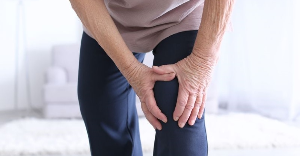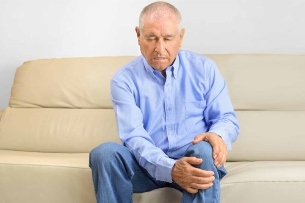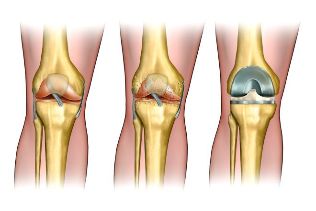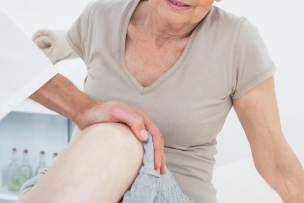Osteoarthritis of the knee joint (the knee) is an injury to the knee joint, especially not to the inflammatory nature which leads to the wear and tear of the cartilage midsole of the knee joint and, with time, to the destruction of the cartilage, the deformation of the knee and limitation of mobility. Therefore, it is important to be able to recognize the disease and know how to, and how it can be treated.

Osteoarthritis of the knee joint (also known as the gonarthroseom – from the Greek "hunting" – knee) is a progressive degenerated degenerative defeat of the cartilage that lines the surface of the joint, which leads to the breakdown of its work and the pain felt.
The causes of osteoarthritis of the knee
The knee is divided into primary (from oneself) and secondary, which occurs as a result of other diseases of the knee joint.
Primary
Osteoarthritis primary (genuinny) – this is osteoarthritis, starting without the causes and striking unchanged the articular cartilage in several joints at the same time. It is most common in people aged over 40 years. It has also been proven that women are more likely than men to suffer from osteoarthritis of the knee and joints of the hands.
Why is primary product of the oa, in the end, we don't know, but, probably, which leads to metabolic disorders. This causes changes in the biochemical reactions that occur in the cartilaginous tissue. With time, it collapses, degenerates and collect the salt. The surface of the knee joint varies with the structure of the cartilage, resulting in the tribe of accumulations of liquid and you get a cyst Becker.
Secondary
It is the result of diseases or injuries of the joints, its clinical manifestations do not differ from the primary. Develops in almost all joints.
Secondary osteoarthritis occurs for a number of reasons:
- the inflammatory process in autoimmune or infectious origin;
- dysplasia or traumatic injury to the meniscus or knee (miniscope);
- diseases intra-articular bone formant articulation of the knee;
- rheumatoid arthritis rheumatoid, arthritis;
- institute bone;
- ankylosis spondylitis;
- the arthritis, occurring in Paget's disease.
The symptoms

The symptoms of osteoarthritis are the following:
- the pain in the feet, knees, hips, lower back;
- stiffness, stiffness and cracking in the joints;
- the pain after sleeping or a long stay in the same position;
- the swelling of the joints;
- pain during change of weather;
- the pain in the joints after the charge;
- the injuries, illnesses, sprains, as well as damage to the menisci;
- the increased loads;
- overweight and obesity;
- low-ligamentous apparatus – disordered ligaments;
- violation of metabolic processes in the body;
- the stress.
The deformation of the joint
The deformation of the joint, it is the change of the shape of the joint, caused by the displacement of the ends of the mating of bone during the dislocation, the development of the joint pathological tissue of growths. The more often suffer from deformation of the joints of brushes, the feet, the shins.
The deformation of the joints is usually a consequence of metabolic disorders complex in periarticular, bone, or cartilaginous tissue, which have the property to accumulate atypical in this location and the concentration of a substance.
A consequence of the deformation of the joint often becomes the concretion of the joints, bony growths, subluxations of the joints and damage to the muscular-ligamentous apparatus.
In relation to this guarantee based on the knee applicable to a symptomatic treatment, but an integrated approach, aimed at eliminating the disease in its whole, demonstrates greater efficacy and prevents the recurrence.
The diagnosis of the deformity of the joint occurs independently of the stage's general diagnosis. It is located at the base of the continuation of the investigation and the general conclusion. Objective study of the joints allows to determine the configuration, the swelling, pain during palpation and movements, the volume of assets and liabilities of detection of movement in the joints and the changes of the skin and subcutaneous tissue in the area of the joints.
The limitation of the mobility of the joint
Secrete various degrees of stress light, barely noticeable breach in the usual amount of motion, up to total loss of mobility.
Depending on the degree of restriction of the mobility of the joint can be distinguished:
- Ankylosis complete immobility in the diseased joint.
- Rigidity – recorded only a low volume of movements. For example, the small rocking motion. During the consideration of the rigidity must be differentiated from the ankylosis.
- Contracture limits the mobility of the persistent and significant, but, nevertheless, there is a bit of the scale of movements in the joint. Diagnose the amount of motion using a simple protractor.

The degree of osteoarthritis of the knee joint
The first. In this case, the disease is characterized by mild pain during active movement. May accumulate in the synovial fluid in the joint cavity, resulting in the formation of a cyst Baker. The pain occur during movement, but go into the state of rest. Cartilage, the tissue is damaged, but externally, the deformation of the articulation of the invisible.
The second. Occurs a narrowing of the joint space, the cartilage tissue which has been damaged to a large extent. On the photo, received in an x-ray, we can notice the intensification of the os. Sharp pain is accompanied by any movement, which involves the knee joint. In a state of rest of the unpleasant sensations that go, but iup will again appear. Pain adds a characteristic popping sound when the fulfillment of extensor movements.
The third. Places the cartilage, the tissue is thin, formed of the barren land of the os. On the x-ray a large number of osteophytes – salt deposits in the joint cavity. In addition, it can be found without the body.
The possible complications and consequences of osteoarthritis of the knee
Osteoarthritis of the knee joint is a degenerative disease, which with time progresses. Joint pain and stiffness in the economic so strong, that the patient is not able to perform the tasks of daily living. Some people lose the ability to work, when the osteoarthritis is at this stage that the doctor recommends that the operation of replacement of the joints.
If you ignore the symptoms of the disease and not to do the treatment in a timely manner, the risks of complications are high.
The possible consequences of the execution of osteoarthritis are the following:
- critique of the deformation of the joint, its destruction;
- world, the modest motor abilities;
- the onset of disc herniations;
- a decrease in the quality of life, the loss of integrity.
What is the doctor?
This may be a general practitioner, ben teen, orthopaedic surgeon. As the necessity to prescribe a consultation with a rheumatologist. Doctor a rheumatologist will examine You, will establish a diagnosis, determines what links should be surprised. Appoint a laboratory and diagnostic methods.
Only with the help of the full survey that the specialist is able to answer the main question: what stage of the knee of the patient and the treatment that is required.
If you have co-morbidities in spinal post requires the consultation of a neurologist and vertebrologist. These specialists shall appoint restorative treatment, in which is set the pain syndrome, to the detriment of the nerve fibers of the intervertebral discs.

The diagnosis
Lesions of the joint, like arthritis, occur in many other diseases, and ignorant people are mistaken often in the definition of the disease. Therefore, in any case, do not try to diagnose yourself.
Instrumental of the investigation
X-ray diagnostics is the most popular and important method because of its simplicity, availability, and information. Photos are generally performed in two projections – the lateral and the line, but can, if necessary, to use and various individual installation.
Ultrasound is considered to be very promising, allowing to detect the liquid, in order to evaluate the pathologies of the soft tissues, as well as to visualize the cartilage and joint surfaces. The advantages of this method before the x-ray applies to the possibility of changing the position of the probe, as well as the lack of need of strict positioning of the patient in order to obtain projections.
The MRI and the ct scan provide a wealth of information, as well as the possibility of obtaining a three-dimensional representation of the study area.
The laboratory analyses
Patients the knee abnormal changes occur primarily within the articular cartilage, as well as in the subchondral bone, the synovium, other soft tissues of the hip. Because the possibilities to explore these structures are limited, the most important sources of collection on the biological markers include blood, urine, and synovial fluid.
In most cases, in patients with osteoarthritis of the knee joint has not changes in the blood and urine, except in cases of synovitis, with large effusion, when there is an increase in the erythrocyte SEDIMENTATION rate, hypergammaglobulinemia, improve the level of indicators of the acute phase – CRP, fibrinogen, and other in the study of the synovial fluid in important differences compared to the normal indicators do not reveal.
In recent years, the intensive course is to find biological markers (BM) degradation and repair of joint tissues (mainly cartilage and bone). BM reflect the dynamic changes are used as predictors of the prognosis of knee osteoarthritis and the markers of the effectiveness of disease treatment. The opening of new and more in-depth study of the famous BM will better understand the mechanisms of the pathogenesis of osteoarthritis.
However, the main problem of the use of biological markers of metabolism of cartilage – evaluation chondroprotective properties of drugs and surveillance of drugs belonging to the group of "disease-modifying".
The treatment of osteoarthritis of the knee
The treatment of osteoarthritis, to put it mildly, is not the task more simple. Therefore, before you start its difficult to fight against this disease, be sure to find a good doctor, ask for a review in him and with him to make a treatment plan.

Drugs
The more often attributed to medications to relieve inflammation and pain with osteoarthritis of the knee joint is one of the drugs anti-inflammatory non-steroidal in nature. The medications are effective in inflammatory processes, accompanied by synovitis. In addition, these drugs to relieve the pain. However, they do not cure the disease itself.
When taking anti-inflammatory non-steroidal drugs, it is necessary to observe all recommendations of your doctor, because these medications have a number of impressive side effects, especially with long-term application.
Chondroprotectors is a class of drugs that repair muscular and cartilage tissue. Upon receipt of chondroprotectors it is necessary to take into consideration that these drugs are most effective when the treatment of the disease.
Vasodilator drug prescribed in the treatment of osteoarthritis. With the help of them manages to restore the flow of blood in the joint, and relieve the spasm of the small vessels.
As an analgesic most commonly used are ointments or compresses with a warming effect. When the need for rapid relief, can be displayed intra-articular injection of corticosteroids.
Surgery
Needling (minimally invasive intervention). This method applies to the diagnosis of the disease. In joint capsule introduce the needle, by taking one part of the liquid. This allows you to obtain the material for analyses, to reduce the load on the capsule, if necessary, to adopt corticosteroids directly to the site of inflammation.
Arthroscopy. Provides an introduction special of the camera of the arthroscope through small incisions in the skin. The method allows to carefully examine the joint, and remove the ones that had separated fragments of cartilage, eliminating the causes of inflammation and pain.
Peri-articular osteotomy. The essence of the method is depositing the bone with the follow-up of the validation of their from another angle. The operation reduces the load on the joints and eliminate pain over a long period of time. Despite its effectiveness, this type of surgery rarely applies – too much load on the body of the patient, and the long-term rehabilitation.
The arthroplasty. In these cases, when other treatments have not helped, but the illness is completely or almost completely destroys the joints, they are replaced by prostheses made of plastic, metal or ceramic.
The stent is a cumbersome and expensive operation requiring a long rehabilitation. Many patients for several months after a surgical intervention is tormented by the pain. However, this method often is the only alternative to the immobility of the patient. The life span of prostheses modern reached twenty years, and all these years, the patient may live a full life.

Proposal of plan
The plan is first necessary to control your weight. There is evidence that osteoarthritis will develop more often and the more difficult is transferred to the as people who are overweight, so:
- limit the consumption of alcohol, fatty foods, semi-finished products;
- watch the power mode;
- reduce the amount of salt;
- reduce the amount of sweets;
- eat more vegetables and fruit (preferably in season).
The measures for prevention of osteoarthritis
The main measures to prevent the development of knee osteoarthritis are:
- reduction of excess body weight;
- the increase of motor activity;
- a good nutrition;
- the respect of the principles of healthy living.
A healthy lifestyle will improve Your body, improve the state of cartilage, joints and bones. You must give up alcohol and smoking. Spend a lot of time in the open air to experience less stress and emotion, a little more good-natured and positive.
Osteoarthritis is a disease that will not heal completely, however, its development, you can stop, if the time to pay attention to their health and to undertake a treatment. The treatment can decrease or even completely remove some of the symptoms greatly facilitate the life of the sick person.

















